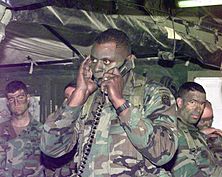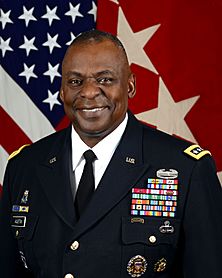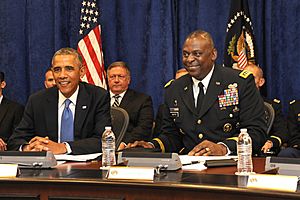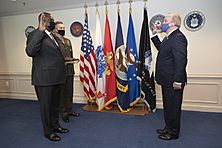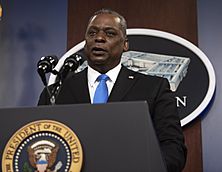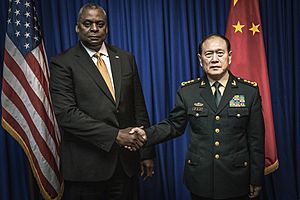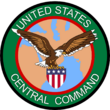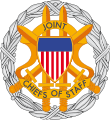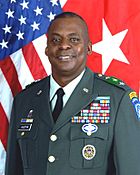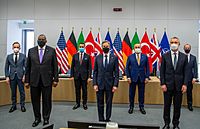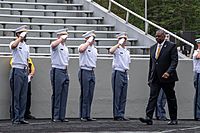Lloyd Austin facts for kids
Quick facts for kids
Lloyd Austin
|
|
|---|---|

Official portrait, 2023
|
|
| 28th United States Secretary of Defense | |
| Assumed office January 22, 2021 |
|
| President | Joe Biden |
| Deputy |
|
| Preceded by | Mark Esper |
| 12th Commander of United States Central Command | |
| In office March 22, 2013 – March 30, 2016 |
|
| President | Barack Obama |
| Preceded by | Jim Mattis |
| Succeeded by | Joseph Votel |
| 33rd Vice Chief of Staff of the Army | |
| In office January 31, 2012 – March 8, 2013 |
|
| President | Barack Obama |
| Preceded by | Peter W. Chiarelli |
| Succeeded by | John F. Campbell |
| 40th Director of the Joint Staff | |
| In office August 9, 2009 – June 30, 2010 |
|
| President | Barack Obama |
| Preceded by | Stanley A. McChrystal |
| Succeeded by | William E. Gortney |
| Personal details | |
| Born |
Lloyd James Austin III
August 8, 1953 Mobile, Alabama, U.S. |
| Spouse |
Charlene Banner
(m. 1980) |
| Education |
|
| Profession | Army officer |
| Signature |  |
| Military service | |
| Allegiance | United States |
| Branch/service | United States Army |
| Years of service | 1975–2016 |
| Rank | General |
| Commands |
|
| Battles/wars |
|
| Awards | Full list |
Lloyd James Austin III (born August 8, 1953) is a retired United States Army four-star general who is serving as the 28th United States secretary of defense since January 22, 2021. Before retiring from the military in 2016, Austin served as the 12th commander of United States Central Command (CENTCOM), beginning in March 2013. Prior to that he served as the 33rd vice chief of staff of the Army from January 2012 to March 2013, and as commander of United States Forces – Iraq from September 2010 to December 2011. He was the first African American to hold each of these positions. After retiring from the armed services Austin joined the boards of Raytheon Technologies, Nucor, Tenet Healthcare, and Auburn University. On December 7, 2020, he was nominated for defense secretary by then-President-elect Joe Biden. He was confirmed by the United States Senate on January 22, 2021, by a vote of 93–2.
Austin holds the unique distinction of having commanded in combat in Iraq and Afghanistan at the one-, two-, three- and four-star levels, and was the first African American to command a division, corps, and field army in combat. He is a recipient of the Silver Star, the nation's third highest award for valor, for his actions during the Iraq invasion, as well as five Defense Distinguished Service Medals.
Contents
Early life and education
Austin was born on August 8, 1953, in Mobile, Alabama; he was raised in Thomasville, Georgia. He graduated from the United States Military Academy at West Point with a Bachelor of Science degree in 1975, where he was commander of G-1 (G Company, 1st Regiment). He later earned a Master of Arts degree in counselor education from Auburn University's College of Education in 1986, and a Master of Business Administration in business management from Webster University in 1989. He is a graduate of the Infantry Officer Basic and Advanced courses, the Army Command and General Staff College, and the Army War College.
Military career
Austin was commissioned as a second lieutenant after his graduation from West Point. His initial assignment was to the 3rd Infantry Division (Mechanized) in Germany.
Following this assignment and attendance at the Infantry Officer Advanced Course, he was assigned to the 82nd Airborne Division at Fort Bragg, North Carolina, where he commanded the Combat Support Company, 2nd Battalion (Airborne), 508th Infantry and served as the Assistant S-3 (Operations) for 1st Brigade, 82nd Airborne Division.
In 1981, Austin was assigned to Indianapolis, Indiana, where he was the operations officer for the Army Indianapolis District Recruiting Command, and where he later commanded a company in the Army Recruiting Battalion. Upon conclusion of this assignment, he attended Auburn University, where he completed studies for a master's degree in education. He was then assigned to the Military Academy at West Point, New York, where he served as a company tactical officer for E-1.
After his selection and subsequent completion of the Army Command and General Staff College, Fort Leavenworth, Kansas, he was assigned to the 10th Mountain Division (Light Infantry), Fort Drum, New York, where he served as the S-3 (Operations) and later executive officer for the 2nd Battalion, 22nd Infantry. He subsequently served as Executive Officer for 1st Brigade, 10th Mountain Division (Light Infantry), and later as Director of Plans, Training, Mobilization, and Security for Fort Drum, New York.

In 1993, Austin returned to the 82nd Airborne Division at Fort Bragg, North Carolina where he commanded the 2d Battalion (Airborne), 505th Infantry. He later served as the G-3 for the 82nd Airborne Division. Following graduation from the Army War College, he commanded the 3rd Brigade, 82nd Airborne Division at Fort Bragg, North Carolina.
Shortly after brigade command, he served as Chief, Joint Operations Division, J-3, on the Joint Staff at The Pentagon in Arlington, Virginia. His next assignment was as Assistant Division Commander for Maneuver (ADC-M), 3rd Infantry Division (Mechanized), Fort Stewart, Georgia. As the ADC-M, he helped lead the division's invasion of Iraq in March 2003. Austin was awarded a Silver Star for his actions as commander during the invasion.
Austin served from September 2003 until August 2005 as the commanding general of the 10th Mountain Division (Light Infantry), as Commander, Combined Joint Task Force 180, during the War in Afghanistan. His next position was chief of staff of the United States Central Command at MacDill AFB, in Tampa, Florida, from September 2005 until October 2006.
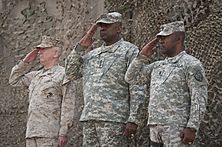
On December 8, 2006, Austin was promoted to lieutenant general, and assumed command of the XVIII Airborne Corps, Fort Bragg, North Carolina. In February 2008, Austin became the second highest ranking commander in Iraq, taking command of the Multi-National Corps – Iraq (MNC-I). As commander of MNC-I, he directed the operations of approximately 152,000 joint and coalition forces in all sectors of Iraq.
Austin handed over command of XVIII Corps to become Director of the Joint Staff in August 2009. This promotion came at the direction of Admiral Michael Mullen, Chairman of the Joint Chiefs of Staff at the time. While Director, Austin was told by Mullen to increase the diversity of the Joint Staff. Austin credited the appointment as having jumpstarted his later career, saying: "People who might not have known Lloyd Austin began to know him."
Commanding General of US Forces – Iraq
On September 1, 2010, Austin became Commanding General (CG) of United States Forces – Iraq (USF-I) at a ceremony at Al-Faw Palace in Baghdad. He assumed the role from General Ray Odierno. As CG, USF-I, Austin was the senior military commander in charge of all US and remaining coalition forces in Iraq. Their mission was to advise, train, assist, and equip the Iraqi Armed Forces and the security agencies part of the Ministry of the Interior. As commander, Austin requested an additional troop presence in Iraq from 14,000 to 18,000.
Austin oversaw the transition from Operation Iraqi Freedom and combat operations to Operation New Dawn and stability operations focused on advising, assisting, and training the ISF. He was extensively involved in the internal U.S. discussions and then negotiations with the Iraqi Government leading up to the signing of the Strategic Partnership Agreement. Opposing total U.S. withdrawal, Austin preferred that the U.S. maintain about 10,000 troops in Iraq after 2011 and he approved staff planning for up to 20,000 remaining troops. He directed the drawdown of forces and the redeployment of approximately 50,000 service members. The U.S. command in Iraq formally cased its colors on December 15, 2011, at a reduced-sized BIAP complex, and Austin's speech there cited his division's seizure of the airport over eight years beforehand. Austin, along with other members of the USF-I staff, departed Iraq on December 18, 2011.
Army Vice Chief of Staff
In December 2011, Austin was nominated to become Vice Chief of Staff of the United States Army (VCSA). He took office on January 31, 2012. As VCSA, he managed the day-to-day administration of the Army's budget and headquarters staff. ..... He also supervised a review of the psychiatric treatment of personnel assessed for disability by the Army.
United States Central Command
Austin became the commander of CENTCOM on March 22, 2013, after being nominated by President Obama in late 2012. Austin was preceded as CENTCOM Commander by General James Mattis, whom Austin would later succeed as Secretary of Defense. In this capacity, General Austin oversaw all United States troops deployed and major United States Military operations around the area of Middle-East and Central Asia and some parts of South Asia. The area of command consisted of 20 countries including Iraq, Syria, Yemen, Afghanistan, Egypt and Lebanon.

His approach as CENTCOM commander has been described as that of an "invisible general", due to his reluctance to speak publicly about military matters.
As commander, after ISIL seized control of Mosul in June 2014, Austin oversaw the development and execution of the military campaign plan to counter ISIL in Iraq and Syria. He had earlier described ISIL as a "flash in the pan". Obama would later tell The New Yorker that ISIL was a "jayvee" team. As of October 2014, Austin argued that the U.S. military's primary focus in operations against ISIL should be Iraq, as opposed to Syria. In 2015, Austin conceded in a Senate Committee on Armed Services hearing that a CENTCOM-developed U.S. program intended to train Syrians to combat ISIL had not been successful. At the hearing, he faced particularly pointed questioning from Senator John McCain over the direction of military engagement in Syria.
Austin's retirement ceremony took place at Joint Base Myer–Henderson Hall on April 5, 2016. During his departure and retirement ceremony, General Austin said that he was extremely proud of the achievements of the coalition's forces which always goes back to the troops. General Austin said "I'm very proud to have had the opportunity to lead troops in combat, I have seen our young leaders do amazing things in really tough and dangerous situations."
Private sector
Immediately after retiring as CENTCOM Commander, Austin joined the board of Raytheon Technologies, a military contractor, in April 2016. As of October 2020[update], his Raytheon stock holdings were worth roughly $500,000 and his compensation, including stock, totaled $2.7 million. On September 18, 2017, he was appointed to Nucor's board of directors. On May 29, 2018, Austin was appointed as an independent director on the board of Tenet Healthcare. He also operates a consulting firm and has been a partner at Pine Island Capital, an investment company with which Secretary of State Antony Blinken and Michèle Flournoy are affiliated.
Secretary of Defense (2021–present)
Upon assuming the office, Austin announced his top three priorities for the Defense Department in a memorandum issued to all DoD employees. It stated in part, "As the Secretary of Defense, I am committed to ensuring that the Department develops the right people, priorities, and purpose of mission to continue to defend our Nation from enemies foreign and domestic. This will require aligning our priorities and capabilities to a changing and dynamic threat landscape. We will do so in a way that is based on a sober assessment of our strategic needs and recognize the importance of building and sustaining a strong workforce and unity within our Department, across the Nation and with our allies and partners around the world. Three priorities - defending the Nation, taking care of our people, and succeeding through teamwork - will guide our efforts."
On March 28, 2023, Austin testified before the Senate Armed Services Committee on DoD's Budget Request for Fiscal Year 2024 and the Future Years Defense Program. In his opening statement he reiterated the objectives of the 2022 National Defense Strategy (NDS):
"The NDS directs the Department to act urgently to sustain and strengthen U.S. deterrence, with the [People's Republic of China] as our pacing challenge. The NDS also directs the Department to tackle the acute threat of Russia, as well as the persistent threats from Iran, the Democratic People's Republic of Korea (DPRK), and global terrorist groups. The NDS clearly articulates our priorities: defend the homeland from the growing, multi-domain challenge posed by the PRC; deter strategic attacks against the United States, our Allies, and our Partners; deter aggression, while preparing to prevail in conflict if necessary, by prioritizing the PRC challenge in the Indo-Pacific, followed by the Russian challenge in Europe; and build a resilient Joint Force and defense ecosystem."
Several days after assuming office as Secretary of Defense, Austin visited the National Guard deployed to Washington D.C. Austin praised the Guard for protecting the Capitol in the days after the January 6, 2021 attack on the United States Capitol. During a press conference, he confirmed that the National Guard was expected to leave the U.S. Capitol within weeks and that there would be no further requests from federal authorities or lawmakers to keep the National Guard's troops in the Capitol complex following their March departure. Austin would subsequently order the troops stay through May.
Part of Austin's primary agenda as Secretary of Defense was the Department of Defense's plan—in coordination with Anthony Fauci, the chief medical advisor to the president—to confront the COVID-19 pandemic within the department. Austin's first step was to urge service members to get vaccinated, especially after the revelation that almost one-third of active-duty service members had turned down the opportunity to get administered the vaccine. In order to tout the safety of the coronavirus vaccine, Austin took the vaccine himself and also emphasized that taking the coronavirus vaccine will prevent disease among the troops, particularly those who were deployed overseas.
Among his early acts as Secretary of Defense, Austin removed former president Trump's appointees from the Pentagon advisory boards. As part of a review, he ordered their resignations, most notably former House Speaker Newt Gingrich and former Trump campaign manager Corey Lewandowski. Many of those removed were last minute political appointees after the 2020 election.
Middle East
Throughout his tenure, Austin has engaged with civil and military leaders in the Middle East, reinforcing the United States' commitment to partnerships and security in the region. Areas for collaboration between the U.S. and allies include integrated air and missile defense, maritime security, intelligence sharing and early warning systems.
There are more than 30,000 U.S. troops in the Middle East, despite the United States' withdrawal from Afghanistan and significant drawdown in Iraq.
At the AIPAC Political Leadership Forum in January 2023, Austin stated: "Our network of alliances and partnerships is one of America's core strategic strengths. And no other country on Earth has anything like it. And that's especially important in today's Middle East."
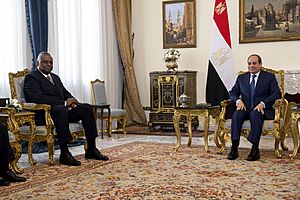
During a speech delivered at the Manama Dialogue in Bahrain in November 2021, Austin said: "We do crucial work together with our friends in this [Middle East] region—to deter aggression from any quarter, to disrupt terrorist networks, and to maintain freedom of navigation in some of the world's most important waterways. And over the decades, we have worked side-by-side as you invested in the capabilities to defend yourselves. We've supported you along the way, and we're going to keep doing so. Our forces train together, plan together, and work together—and that makes us stronger together."
He went on to say: "So we're going to build on our longstanding investments in this crucial region—in security cooperation, and training, and professional military education, capacity building, and intelligence sharing, and joint exercises. It is a core part of my mission as Secretary of Defense to deepen and widen our partnerships."
On July 16, 2022, President Biden met in Jeddah with the leaders of the Gulf Cooperation Council (GCC) – Bahrain, Kuwait, Oman, Qatar, Saudi Arabia, and the United Arab Emirates – the Republic of Egypt, the Republic of Iraq, and the Kingdom of Jordan (together known as the GCC+3) for the first of its kind "Jeddah Security and Development Summit". At the Summit, Biden reiterated the importance the United States places on its decades-long strategic partnerships in the Middle East region, affirmed the U.S.' enduring commitment to the security and territorial defense of U.S. partners, and recognized the region's increasingly important role as a trade and technology crossroads between hemispheres. He also strongly affirmed the centrality of the Middle East region to the long-term security and prosperity of the United States and the American people.
Iran
During a visit to Israel in March 2023, in a joint press conference with Israeli Defense Minister Yoav Gallant, Austin said: "Iran remains the primary driver of instability in the region and we remain deeply concerned by Iran's support for terrorism, its dangerous proxies, its nuclear advances, its aggression at sea, its cyber threats, and its proliferation of attack drones and advanced conventional weapons."
At the AIPAC Political Leadership Forum on January 10, 2023, Austin stated: "Going back to my days at CENTCOM, I have consistently said that the greatest threat to Israeli security, and to the region, is the prospect of a nuclear-armed Iran. We fully understand the dangers of the Iranian government's destabilizing actions—including its support for terrorism, its dangerous proxies, and its threats to wipe Israel off the map. But Iran is also stoking instability across the region—including its support for terrorists and militias, its proliferation of drones, its menacing cyber activities, its maritime aggression, and its continued threats against foreign officials. So Iran's reckless actions don't just threaten Israel. They endanger the entire Middle East and beyond, including by supporting Russia's cruel targeting of civilians in Ukraine. And increasingly, U.S. partners understand the importance of a regional approach to this kind of shared danger. So we're working closely with Israel, our partners in the Middle East, and our allies and partners to impose coordinated pressure on the Iranian regime."
On February 19, 2021, Austin spoke to Saudi Crown Prince Mohammed bin Salman, saying that "We discussed the continued commitment to the 70-year US-Saudi security partnership, and I'm looking forward to working together to achieve regional security and stability." Austin expressed support for Saudi Arabia in the Iran–Saudi Arabia proxy conflict.
On February 25, 2021, under Biden's direction, Austin coordinated military defensive airstrikes against an Iranian-backed militia in Syria. Austin had previously recommended such airstrikes as a response to Iranian attacks on Americans in Iraq earlier in the month.
Combatting terrorism
During his testimony before the Senate Armed Services Committee on March 28, 2023, Austin stated that, "ISIS, al-Qa'ida, and other terrorist groups continue to threaten the security of the United States, our citizens, and our Partners in the Middle East, Africa, and South Asia. We are investing in a modernized, over-the-horizon counterterrorism architecture to prevent future attacks on our citizens and the U.S. homeland, and we have proven our continued ability to remove the most threatening al-Qa'ida and ISIS operatives from the battlefield."
Israel
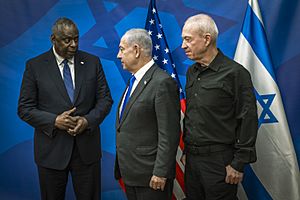
"America's commitment to Israel's security is ironclad. It is not negotiable. And it never will be."
In January 2023, the U.S. and Israel conducted the largest U.S.-Israel partnered exercise in history: Juniper Oak 23.2. The exercise integrated unmanned aerial vehicles, strategic bombers, jet fighters and precision fires. U.S. and Israeli forces conducted long-range strikes, suppression of enemy air defense, electronic attacks, offensive counter and air interdiction, and air operations in the maritime domain. More than 7,000 personnel participated in the all-domain exercise.
On October 7, 2023, the terrorist group Hamas invaded Israel and killed more than 1,400 people and kidnapped 239 civilians, according to Israeli statistics. It was the deadliest terror attack in Israel’s history, and the bloodiest day in Jewish history since the end of the Holocaust.
On October 8, 2023, the day after the Hamas attack on Israel, Austin directed Gerald R. Ford carrier strike group to the Eastern Mediterranean in response. Along with the carrier, the group also included the cruiser Normandy and the destroyers Ramage, Carney, Roosevelt, and Thomas Hudner. On October 13, 2023, he arrived in Israel and met with Israeli Defense Minister Yoav Gallant. Austin said: "I am here in person to make something crystal-clear: America's support for Israel is ironclad."
Since the initial Hamas attack, Pentagon Spokesman Brig. Gen. Pat Ryder said the Department has focused its efforts on protecting American forces and citizens in the region, flowing security assistance to Israel, coordinating with Israelis to secure the release of hostages held by Hamas and strengthening the force posture across the region in order to deter any escalation of the conflict beyond Gaza.
On November 28, 2023, the U.S. airlifted 24.5 metric tons, or more than 54,000 pounds, of U.N. humanitarian supplies to the people of Gaza. At the request of USAID, these supplies were transported via a U.S. Air Force C-17 Globemaster aircraft to Egypt where they were then transported via ground into Gaza and then distributed by U.N. agencies.
Indo-Pacific
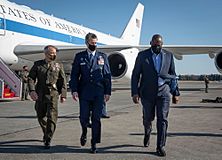
In his testimony before the House Armed Services Committee on March 29, 2023, Austin said: "The PRC is our pacing challenge. And we're driving hard to meet it. Our budget builds on our previous investments to deter aggression. We're investing in a more resilient force posture in the Indo-Pacific and increasing the scale and the scope of our exercises with our partners.
And in recent months, our friends in the Indo-Pacific have taken major steps forward. The Philippines has agreed to nearly double the number of sites where we cooperate together. Japan has committed to double its defense spending. And through the historic AUKUS partnership, we'll work with our Australian and British allies to build game-changing defense advantages that will deter aggression and boost our defense industrial capacity."
In March 2021, as part of their first overseas trip as members of the Biden administration, Austin and Secretary of State Antony Blinken visited Japan and South Korea. The trip reflected the Biden administration's concerns about China's growing influence within the Indo-Pacific region, especially their military buildup during the pandemic, as well North Korea's nuclear threat and the February 2021 coup d'état in Myanmar. The trip was also part of the Biden administration's "America is back" diplomatic theme, and Austin pledged the U.S.'s commitment to reaffirm ties with its allies and to maintain a robust military presence in the Indo-Pacific region. Austin added that denuclearization of the Korean Peninsula remains a top priority for the Biden Administration, and that the alliances with South Korea and Japan are among the most important tools the United States has in that regard.
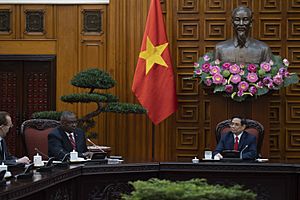
On March 16, 2021, the Japan-U.S. Security Consultative Committee (SCC) (Japan-U.S. "2+2") was convened in Tokyo. The meeting was attended by Austin and Blinken from the U.S. side, and Foreign Minister Motegi Toshimitsu and Defense Minister Kishi Nobuo from the Japanese side. The four ministers reaffirmed that the Japan-U.S. Alliance remains the "cornerstone" of peace, security, and prosperity in the Indo-Pacific region, and renewed the unwavering commitment of both countries to the Japan-U.S. Alliance.
In June 2023, as part of his seventh official visit to the Indo-Pacific region, Austin traveled to Tokyo to meet with his Japanese counterpart, Defense Minister Yasukazu Hamada and other senior leaders, including Prime Minister Kishida Fumio and Foreign Minister Yoshimasa Hayashi. Austin's visit comes as the United States and Japan take important strides to modernize Alliance capabilities, optimize U.S. force posture, and build links with like-minded partners following the historic U.S.-Japan "2+2" Ministerial meeting earlier this year.
In July 2023, Austin traveled to Australia where he participated in the 33rd Australia/U.S. ministerial consultations, also called AUSMIN. Following the meeting, DoD officials stated, "the unbreakable alliance between the United States and Australia has never been stronger" and "it is doing more than ever for peace and stability in the Indo-Pacific."
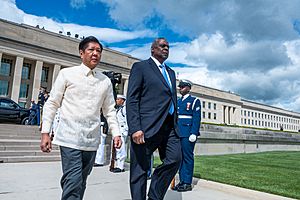
In March 2021, Austin also made a three-day visit to India, where he met with his Indian counterpart Rajnath Singh, and other senior government officials. India drew closer to the United States following its tensions with China on their disputed Sino-Indian border. Austin urged India to cancel the planned purchase of Russia's S-400 air defence system.
Austin made a second visit to India in June 2023, where he again met with Defense Minister Rajnath Singh as well as other senior leaders to discuss the ongoing joint efforts to modernize the U.S.-India Major Defense Partnership.
The India-U.S. defense partnership has strengthened considerably in the last few years with the countries signing key defense and security pacts, including the Logistics Exchange Memorandum of Agreement in 2016 that allows their militaries to use each other's bases for repair and replenishment of supplies.
During a press conference following Austin's visit to New Delhi, a senior Defense Department official described the progress between the U.S. and India: "India's growing commitment to playing a more engaged international role, including in the Indo-Pacific Quad, demonstrates a new and growing willingness to join the United States to protect and advance a shared vision of a free, open and rules-based global order.
On June 11, 2022, Austin condemned China's "provocative, destabilising" military activity near Taiwan, a day after China's Defence Minister Wei Fenghe warned Austin that "if anyone dares to split Taiwan from China, the Chinese army will definitely not hesitate to start a war no matter the cost." Austin said the United States "will continue to fulfill our commitments under the Taiwan Relations Act. That includes assisting Taiwan in maintaining a sufficient self-defense capability." By February 2023, he had secured the U.S. military access to nine military bases in the Philippines, which is orthogonally situated between Taiwan and the South China Sea, expediting the full implementation of the Enhanced Defense Cooperation Agreement signed during the Obama administration. At the June 2023 Shangri-La Dialogue in Singapore, Austin warned that conflict in the Taiwan Strait would be devastating.
In November 2023, Austin traveled to Jakarta, Indonesia for the ASEAN Defense Ministers' Meeting-Plus where he emphasized the U.S. commitment to ASEAN centrality as a key pillar of the United States’ efforts to uphold a free and open Indo-Pacific and detailed how U.S. security cooperation with ASEAN partners is contributing to a more stable and prosperous region. On the margins of the ADMM-Plus, Austin also met with each of his ASEAN counterparts from the Philippines, Indonesia, Thailand, and Vietnam.
Afghanistan
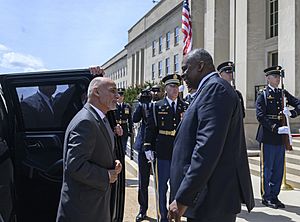
On February 19, 2021, Austin told reporters at the Pentagon that the Biden Administration had not yet determined whether the U.S. would withdraw all troops from Afghanistan by the May 1 deadline set by the Trump administration in February 2020 as part of the Doha Agreement, a deal reached between the United States and the Taliban. The Biden administration was considering a six-month extension. Austin promised that the United States "will not undertake a hasty or disorderly withdrawal from Afghanistan." On March 21, 2021, Austin met with Afghanistan President Ashraf Ghani in Kabul.
In March 2021, Biden directed his national security team, including Austin, to begin withdrawal planning that accounted for a range of possible contingencies, including a non-combatant evacuation operation (NEO). On April 14, 2021, in an address to the nation, President Biden announced that a new deadline for full withdrawal of all U.S. troops had been set for September 11, 2021. "After consulting closely with our allies and partners, with our military leaders and intelligence personnel, with our diplomats and our development experts, with the Congress and the Vice President, as well as with [Afghan President Ashraf Ghani] and many others around the world, I concluded that it's time to end America's longest war. It's time for American troops to come home," he said.
Soon after the withdrawal of U.S. troops started, the Taliban launched an offensive against the Afghan government, quickly advancing in front of a collapsing Afghan Armed Forces. On July 24, 2021, Austin said: "In terms of whether or not [Afghanistan's military] will stop the Taliban, I think the first thing to do is to make sure that they can slow the momentum."

On August 12, 2021, following continued Taliban victories across Afghanistan, the Biden Administration announced that 3,000 U.S. troops would be deployed to Kabul Airport to evacuate embassy personnel, US nationals and Special Immigrant Visa applicants. Over the next few weeks, the Defense Department oversaw one of the largest airlifts in history, evacuating more than 120,000 Americans, Afghans and people of other nationalities. In a statement issued on the one-year anniversary of that devastating attack at Abbey Gate, Austin said: "The heroes we lost that day gave their lives to defend their teammates and to help save the lives of tens of thousands of innocent Afghan people who sought freedom and the opportunity for a better life." On August 30, 2021, the last American service member left Afghanistan.
In December 2021, Austin directed an independent After Action Review (AAR) be conducted to provide a detailed assessment of the Defense Department's implementation of US Afghanistan policy from January 2020 through August 2021. "The purpose of the AAR was to examine decision points, constraints, and assumptions in order to contribute toward a whole-of-government effort to learn, improve and incorporate lessons learned into the Department's response to future crises."
Africa
In September 2023, Austin made his first trip to the Africa continent as Secretary of Defense. He started his tour in Djibouti, home to the primary U.S. military base on the African continent, where he met with Djiboutian leaders and Somalia’s president. He then traveled to Kenya, where he and his Kenyan counterpart signed a five-year security agreement to support working together against their common terror threat. Austin also pledged $100 million in support of Kenyan security deployments, as Kenya prepares to lead a multinational peacekeeping mission to Haiti to combat gang violence. He concluded his trip on Africa’s western coast, becoming the first U.S. defense secretary to ever visit Angola.
In a speech delivered at the National Archives Auditorium in Luanda, Angola on September 27, Austin said:
"I'm here in Angola to strengthen that robust and equal partnership. But I'm also here to underscore an important point, and that is that Africa matters. It matters profoundly to the shape of the 21st Century world. And it matters for our common prosperity and our shared security."
He went on to say: "We know that the walk to freedom can be long, and no one gets it right all of the time. You know, I love my country so much that I fought for it, but America isn't trying to cover up for our imperfections. When a democracy falls short, when it falls short of its best traditions, as we all sometimes do, the whole world gets to see it. But that's not the point. The genius of a democracy is not that it's perfect. The genius of a democracy is that it can always open up space to let its citizen strive to live the universal values of freedom and self-government and human rights.
And the genius of a democracy is that it is always a work in progress, and that's personal for me. I am a child of America's segregated South. I grew up in a time of legalized and racist segregation in America, and I stand here today in Africa as America's first black secretary of defense."
Personal life
Austin was raised by a devoutly Catholic mother and remains practicing himself.
Austin and his wife, Charlene Denise Banner Austin, have been married for over forty years. Charlene worked as a non-profit administrator and served on the board of the Military Family Research Institute at Purdue University. Austin has two stepsons.
Awards and decorations

|
|
||||||||||||||||||||||||||||||||||||||||||||||||||||||||||||||||||||||||||
- 2007 inductee into the Thomasville County Sports Hall of Fame.
Gallery
-
U.S. Secretary of Defense Lloyd Austin with NATO Secretary General Jens Stoltenberg at NATO headquarters in Brussels, April 14, 2021.
-
Secretary of Defense Lloyd Austin during a visit to West Point Military Academy on May 22, 2021.
See also
 In Spanish: Lloyd Austin para niños
In Spanish: Lloyd Austin para niños


